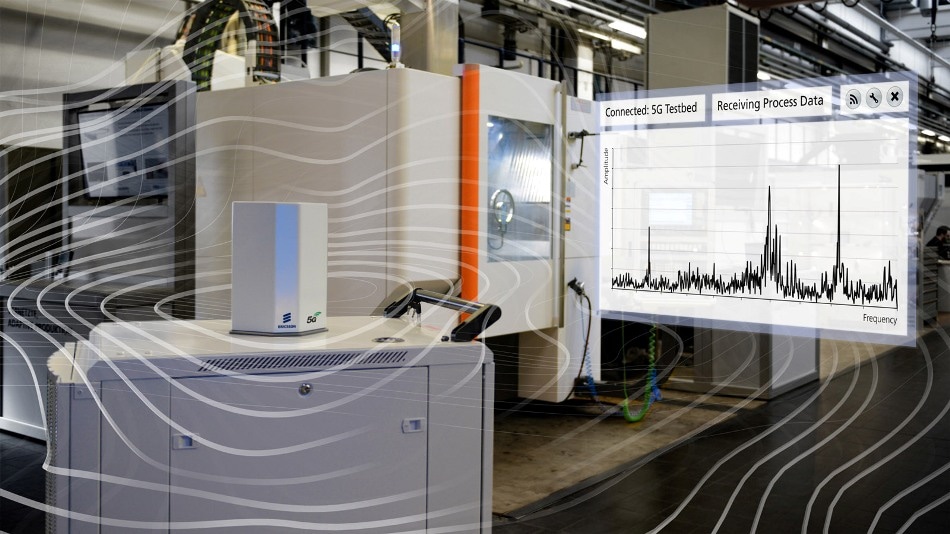By Matt Pullen, B.Sc.Apr 4 2018
Sensors are used to consistently record measurements in machinery and plants to analyze whether operations are carried out according to the plan and to allow identification of errors in the industrial production environment at an early stage.
Yet, customarily, data analysis is decentralized and occurs after a time lag. In stark contrast, the 5G wireless standard allows direct, wireless measurement in real time. Fraunhofer in Aachen has collaborated with Ericsson to develop a distinctive test environment for 5G applications in industry.
The collaborators will be using the example of aero-engine component manufacture to perform live demonstration of, for the first time, the possibilities offered by the technology at the Hanover Fair from April 23 to 27, 2018 (Hall 17, Booth C24).
 A sensor transfers the vibration spectra of the blisk via 5G with sub-millisecond latency to a software. (Image credit: Fraunhofer IPT)
A sensor transfers the vibration spectra of the blisk via 5G with sub-millisecond latency to a software. (Image credit: Fraunhofer IPT)
It is highly expensive and complex to manufacture aero engines. The cost of the entire manufacturing process of a compressor component called blisk, or blade-integrated disk, can be nearly 200,000 Euros. It is important to conform to highest levels of quality and safety standards, and computer-controlled machine tools must be programmed to make sure that the components are manufactured precisely as specified in the design plans. Sensors equipped in the plant and machinery continuously monitor the manufacturing process.
Yet there is always a certain element of residual risk because the quality analysis is decentralized with a considerable time lag. The natural frequencies of the thin-walled blades present a particular problem in production as any uncontrolled vibration has adverse effects on the quality, which have to be corrected via time-consuming manual operations following the production.
Dr. Sascha Gierlings, Head of Prototype Manufacturing at the Fraunhofer-Institute for Production Technology IPT in Aachen
Unique Test Environment in Aachen
A propitious solution to this difficulty would be a combination of the most recent sensor technology and high-speed data transfer rates such as those offered by the future mobile communication standard 5G. In the particular case of manufacturing blisk, the Fraunhofer IPT has directly affixed a uniquely designed sensor to the component.
This transfers blisk’s vibration spectra through 5G with sub-millisecond latency to software that immediately identifies whether the vibrations surpass the allowed maximum or have reached critical frequencies and accordingly adapts the production process without any delay. An added benefit is that the rapid data transfer enables a digital twin, the virtual reflection of a component, to be produced. This twin assists in answering key questions related to the manufacturing process at the computer, before the start of the process.
The Research Institute in Aachen collaborated with Ericsson, the Swedish technology provider in the High-Performance Center Networked, Adaptive Production to develop the live transfer of component data. For the first time, the collaborators will be presenting their solution to the public in a live demonstration at the Hanover Fair at the end of April: The scientists from the Fraunhofer Institute will directly transfer the vibration spectrum of a milled blisk in real time from the sensor to a display unit through 5G technology.
We hope that our appearance at the fair will encourage all interested companies to visit us in Aachen so that they can profit from the unique test environment we have here for 5G applications in industry. Blisk production is only one of many conceivable fields of application. Its complexity, however, makes it particularly suitable for use as a demonstrator.
Niels König, Manager of the Production Metrology Department and Coordinator of 5G activities at the Fraunhofer IPT
Examples of applications such as Blisk production highlight the fact that there is no way round 5G for those striving to future-proof their production. Of course, when you are creating solutions to connectivity as part of Industrie 4.0 it is essential to work side-by-side with a solid partner with a track record of integrity as well as with unsurpassed standards in quality and reliability. Our mission statement in a nutshell.
Stefan Koetz, CEO of Ericsson GmbH
5G from 2020
Proposals are already well in progress to present 5G as the new mobile communication standard by 2020. Apart from low latency times, it assures high data transfer rates of nearly 10,000 megabits per second and enables a number of devices to be operated at the same time in closely linked small radio cells. For the first time, 5G technology thus adapts the application of wireless sensor connections for real-time analyses of data and adaptive control of manufacturing processes with shorter reaction times.
“The greatest challenge facing mobile communications providers from now until 2020 will be to continue to reduce the size of transmission units. From laptop to smartphone or chip size, if possible. Our mission is to develop the measuring and control technology required,” summarized König, detailing the further steps in the development process.